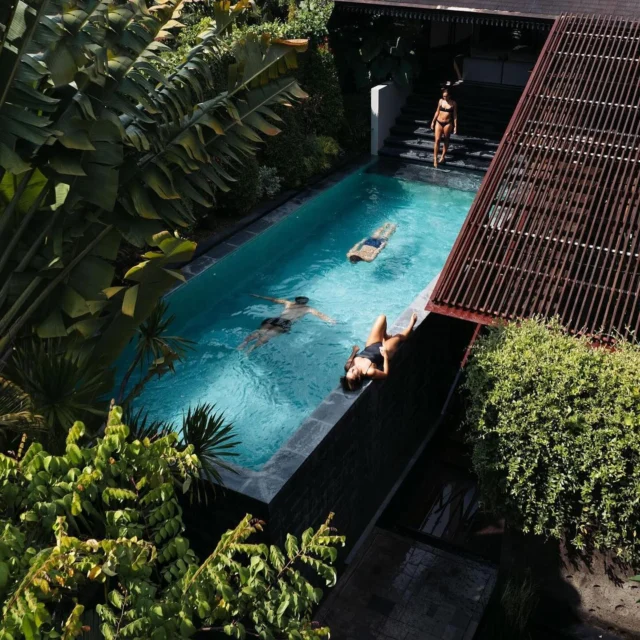March 8, 2023
The Maldives – Not as Flat as You Think
“I was 17 when I first saw people riding waves standing up,” Hussain Areef tells me as we stroll along the timber boardwalk on Kuda Huraa island. “It was intriguing – I wanted to try it out too.”
It’s not really surprising that surfing was such a revelation since at that time the rest of the world was still struggling to accept even the vague possibility that there might be waves in Maldives.
After all, this archipelago of 1,200 islands was primarily famous for its smooth, crystal-clear waters and kaleidoscopic reefs. When the first photos began to appear in international surf magazines surfers all over the world assumed that there had been a typo or a hoax.
We’ve just left our grandly luxurious stilted villas and as we walk along the boardwalk a small blacktip reef shark prowls lithely through the shallows. But this is Maldives and in the manicured version of a tropical paradise that is Four Seasons Kuda Huraa even the grinning sharks seem welcoming.
Hussain Areef – who goes by the nickname Iboo – also has a smile on his face and a glint in his eye. He’s famous throughout the islands as a multiple-winner of the Maldives Surfing Championships and today he feels that he’s finally seeing his country take its rightful place as a respected surf destination.
We’re heading up to the little jetty on the private island to catch a boat for what is certainly the most high-profile event in the history of Maldivian surfing. This is the final day of the Four Seasons Maldives Surfing Champions Trophy, an exclusive invitation-only surf contest featuring local hero Iboo and five of the sport’s legendary names.
During the last few days dreadlocked ‘drifter’ Rob Machado has been battling it out for mastery of Maldives’s finest surf-spot against fellow-Americans and Ross Williams and Taylor Knox and legendary Hawaiian big-wave charger Shane Dorian. I’d been invited along to cover the event for an American magazine and had already landed at Velana international airport and caught the Four Seasons speedboat up to the resort on North Malé Atoll when I was told that a final competitor had been confirmed for the event. Kelly Slater – who has surely travelled to most of the world’s greatest surf venues during the course of a career that saw an unprecedented 11 world championship wins – was flying in to get his first taste of Maldivian waves.
The plan was that later in the week the five pros would have a chance to set of on an exclusive seaplane surfari to explore some of Maldives’ lesser-known surf-spots. It’s astounding that an archipelago that was believed to be entirely free of waves two decades ago should now have at least 40 well-known and well-documented surf-spots.
The king of the Maldivian breaks is said to be the spot known as Sultans, where waves wrap around the southern end of palm-tree-covered Thanburudhoo Island. And a handful of the world’s best surfers had flown here to battle for the crown of Sultans.
“Around 1995 some friends and I went on a surf trip on a dhoni [a local fishing boat] to surf perfect overhead waves at Sultans,” Iboo told me as we motored out to the reef with our boards stacked in the Four Seasons boat. “I was hooked. I’d never seen a wave that long.”
The charging right-hand walls often stretch for 200 metres. Even Australian surfer James Cotton had been impressed by Sultans he told me when we chatted over cocktails at the Four Seasons pool the evening before: it was praise indeed because Cotton holds the Guinness World Record for the longest wave ever surfed (a ride of 17.2 kilometres on the Bono River tidal bore in Sumatra in 2016).
Clearly Maldives was attracting more than its share of surfing legends these days but it was not just the star-studded line-up that made the contest unique. The five pro surfers were being challenged to surf on boards that represented much of the evolution of surfing. They would be tackling the waves on single-fins (icons of the 1960s), twin-fins (with which Mark Richards revolutionised surfing in the 1970s) as well as the modern thrusters (3-fin setup ‘invented’ by Simon Anderson) in the 1980s.
(These were clearly forward-thinking and open-minded surfers but the thruster has remained virtually unchanged for the last 40 years. Perhaps surfing would have a more innovative outlook if more surfers – especially veteran wave-warriors who have little left to prove – were invited to test their skills from time-to-time on more revolutionary shapes. Perhaps even downright bizarre designs or the super-fast new parabolic boards.)
Not surprisingly, Slater – who’s known as the G.O.A.T (Greatest Off All Time) – won the event overall but even for him the battle was often a tough one. After the twin-fin heat I was standing at the back of the Four Seasons Explorer surf-charter boat when Shane Dorian came aboard: “I beat The Goat man!” he called with a big smile. “I’ll take that!”
Slater was smiling too – the pair surfed their first competition together as groms 38 years ago and he had officially credited Dorian as one of his major influences.
“The Maldives is an incredible region to come surf,” Dorian during cocktail hour at the resort bar. “I have been coming here since I was about 20 years old, and the wave quality and water clarity and vibe is amazing. And Sultans is incredibly reliable, consistent and super high-performance – it’s the perfect venue for a surf competition. It’s just so cool to be here with our little group of friends, and to be here with Iboo as well, surfing with and against each other.”
Despite the fact that the wave breaks onto an entirely uninhabited island (as many as a thousand of Maldives’s islands remain uninhabited) Sultans can sometimes get crowded with surfers arriving on boats from various resorts. I surfed every afternoon with the expert surf-guides from Tropicsurf and one afternoon I found myself in the blissful state of absolute solitude. It was the end of a long and perfect session and my guide had paddled off to hail a boat back to the resort. I had time to catch three perfectly peeling head-high breakers that ripped across the mottled reef. It was the first time I’d surfed in Maldives and it was enough to make me curse the years I’d spent assuming that these picturesque coral atolls could not also harbour perfect waves.
On the other side of the peak lay the lefthand wave known as Honky’s. The story of how two Australian surfers – Tony ‘Honky’ Hinde and Mark ‘Scanno’ Scanlon – were shipwrecked here when the yacht they were on (sailing from Sri Lanka to South Africa) hit a reef is part of surfing lore. For a decade or so Maldives remained surfing’s best-kept secret and Hinde fell in love and married a Maldivian lady.
“When I was a kid people viewed surfers as bums,” Iboo told me after the contest was over. “We used to sneak out of the house to go surfing. Even went to the length of dressing in normal clothes and changing to surf clothes stored at friends’ houses near the beach. We’d go out for a surf then return home like nothing happened. People are more aware of the sport and the benefits it has for the country. Attitudes have changed.”
It seemed that many attitudes had changed during the last week too: “I’m really surprised there’s not a World Tour event here,” said Kelly Slater after he won the contest. “The waves are beautiful, they’re playful but it’s really high-performance surf. It’s one of those places that I want to come back to year after year.”
The luxurious Four Seasons Maldives at Kuda Huraa, situated on a private island in North Malé Atoll, is one of Maldives’ most idyllic resorts. It offers everything you could wish for from a resort holiday, along with full diving packages and access (by speedboat and seaplane) to Sultans and other surf spots.
Anantara Dhigu Maldives Resort has launched the Ultimate Surf Break package, offering everything surfing at beginner level at the edge of their private lagoon to hollow, barrelling waves on the outer reefs.
Photo credits: Four Seasons
Written by Mark Eveleigh
























